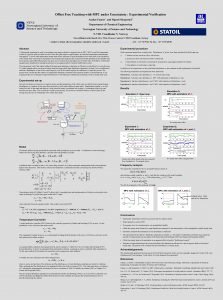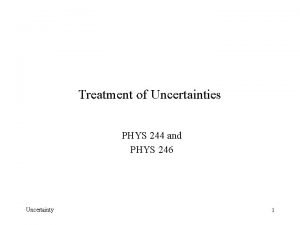Offset Free Tracking with MPC under Uncertainty Experimental

- Slides: 1

Offset Free Tracking with MPC under Uncertainty: Experimental Verification Audun Faanes* and Sigurd Skogestad† Department of Chemical Engineering Norwegian University of Science and Technology N-7491 Trondheim N, Norway *Also affiliated with Statoil ASA, TEK, Process Control, N-7005 Trondheim, Norway † Author to whom all correspondence should be addressed. E-mail: skoge@chemeng. ntnu. no, Tel. : +47 73 59 41 54, Fax. : +47 73 59 40 80 Abstract Temperature Controller Frequency analysis A laboratorial experiment is used to investigate some aspects related to integral action in MPC is used for temperature control of a process with two tanks in series. Since this often improves performance, an extra the temperature measurements was applied. To avoid outlet temperature steady-state offset, estimates of input disturbances have been used in the calculation of the steady-state control input. Simulations may indicate that integral action is present and that disturbances are handled well, but in practice unmodelled phenomena may give a poor result in the actual plant, also at steady-state. If should be verified that integral action (feedback) is actually present and not an apparent effect of perfect feedforward control. A model predictive controller (MPC) based on the controller proposed by Muske and Rawlings (1993) is used. For the predictions we use a discrete state space model We express the controller by the (1 2) transfer function matrix K: The experiments verify that output feedback through input disturbance estimation is efficient, provided that it is correctly done. To obtain integral action, care must be taken when choosing which input disturbance estimates to include. It is not sufficient to estimate a disturbance or bias in the control input(s), even if the control input(s) are sufficient to control the process. The present work verifies that the number of independent disturbance estimates must equal the number of measurements. In our experiment the use of estimates of input disturbances to both tanks gave satisfactory performance with no steady-state error. Experimental set-up Hot and cold water are mixed in two tanks in series, and the temperature of the outlet water (y) shall be kept constant despite disturbances d 1 (variation in hot water flow rate) and d 2 (cold water addition in main tank). Manipulated variable, u, is cold water flow rate. In the main tank there is a loop where the water is circulated with a pump. y is measured in this loop, and therefore we get a delay. The circulation loop also gives mixing. The levels are controlled with an overflow drain (in the mixing tank) and an on-off drainage valve (in the main tank). and introduce scaled variables, u´ and y´, such that the variation in the scaled variables is 1. u´=u/umax and y´=y/ymax. umax = 500 ml/min and ymax= 0. 3°C. Then The manipulated variable at time k, uk, is determined by taking the first element of the vector of N future control moves, , that optimizes the infinite criterion We plot the magnitude of the elements of K´(jw): u is assumed held constant in each sample interval, and we assume u=0 after the N moves. Muske and Rawlings (1993) demonstrated how to derive an equivalent finite optimization criterion. Assuming no active constraints (this assumption is for this case verified by the results), the controller can be expressed as state feedback: MPC with estimation of d 1 and d 2 Integral action: High gain at low frequencies To handle non-zero references and obtain integral action: [rad/min] where xs and us are functions of the reference and the disturbances, d. x and disturbance estimates are found by a Kalman filter, assuming that the disturbance(s) are integrated white noise (with covariance 0. 05). The other states have a covariance of 1, whereas the measurements are assumed to have a covariance of 1000. For details, see Faanes (2003) or Chapter 5 in Faanes and Skogestad (2003). The use of input disturbance estimates is recommended by Muske and Rawlings (1993), Lee et al. (1994), Lundström et al. (1995) and Muske and Badgwell (2002) when the process time constants are long and the actual disturbances are not directly influencing the outputs. Conclusions • Experiment: temperature control in a process with two tanks in series • Model predictive control, MPC Experimental procedure • Non-square case: two measurements, one manipulated variable Each experiment started from a steady state. Disturbances d 1 and d 2 were then introduced the following way: d 1: d 2: 1. Reduce hot flow rate from 500 to 400 ml/min. • Offset-free steady state obtained by input disturbance estimates for the determination of the manipulated variable steady-state 2. Increase hot flow rate back from 400 to 500 ml/min. • Simulation indicates that estimation of one disturbance is sufficient 1. Start addition of cold water to main tank by pouring from a jug (approximately 60 ml/min). • The experiment shows that two disturbance estimates are needed, i. e. , the number of disturbance estimates must equal the number of measurements (in accordance with Pannocchia and Rawlings (2003) and Faanes and Skogestad (2003)) 2. Stop addition of cold water to main tank In addition to the experiments we also performed simulations on the nonlinear model implemented in Simulink. • Offset free steady state in the simulation is an apparent effect of perfect “feedforward control” The following simulations and experiments were performed: Simulation 1. Introduce only disturbance 1. No control (open loop) • Estimates of input disturbances have been described in the literature as efficient for a quick response back to the desired steady state. The present work confirms this (provided that it is correctly done). Simulation 2. Introduce only disturbance 1. MPC with estimation of disturbance 1 only. Acknowledgements Experiment 1. Introduce disturbances 1 and 2. MPC with estimation of disturbance 1 only. Model Experiment 2. Introduce disturbances 1 and 2. MPC with estimation of disturbance 1 and 2. The experimental equipment has been set up at Norsk Hydro Research Centre, and was originally designed by Jostein Toft, Arne Henriksen and Terje Karstang. Norsk Hydro ASA has financed the experiments. We assume perfect mixing and model the main tank with circulation loop as one tank. Combination of mass and energy balance for the mixing tank (labelled 1) and the main tank (labelled 2) yields Results References Simulation 2: MPC with estimation of d 1 Simulation 1: Open loop °C Faanes, A. and Skogestad, S. (2003). On MPC without active constraints. Submitted to Modeling, Identification and Control, MIC. °C In addition there is a delay in tank 1 of 1 and a delay in tank 2 of 2 (these represents transportation delays and neglected higher order dynamics). This model is used in the simulations. Linearization around a nominal point, denoted with an asterisk, yields: ml/min Lee, J. H. , M. Morari and C. E. Garcia (1994). State-space interpretation of model predictive control. Automatica 30(4), 707 -717. ml/min Lundström, P. , J. H. Lee, M. Morari and S. Skogestad (1995). Limitations of dynamic matrix control. Comp. Chem. Engng. 19(4), 409 -421. Time [min] No steady state offset Discretization with cd 2 (Matlab Control Toolbox) with 1 s sampling time and implementation of delays as extra poles in the origin (with delay 2 z) yields state space model with 27 states: where subscript k denotes sample number. This model is used in the MPC. Experiment 1: MPC with estimation of d 1 Experiment 2: MPC with estimation of d 1 and d 2 °C °C ml/min Values: Time [min] Steady state offset despite what was expected from Simulation 2. No integral action. Faanes, A. (2003). Controllability Analysis for Process and Control Structure Design. Ph. D thesis. Department of Chemical Engineering, Norwegian University of Science and Technology. Time [min] No steady state offset. Integral action Muske, K. R. and Badgewell, T. A. (2002). Disturbance modeling for offset-free linear model predictive control. Journal of Process Control. 12, 617 -632 Muske, K. R. and J. B. Rawlings (1993). Model predictive control with linear models. AICh. E Journal. 39(2), 262 -287. Pannocchia, G. and J. B. Rawlings (2003). Disturbance Models for Offset-Free Model-Predictive Control. AICh. E Journal. 49(2), 426 -437.

